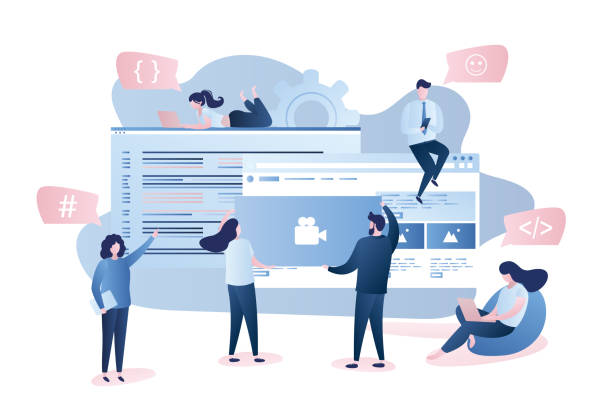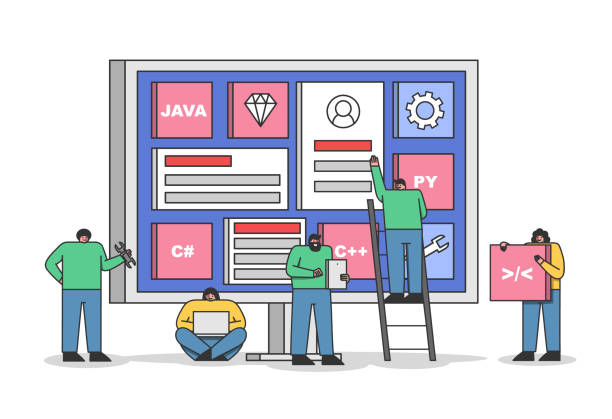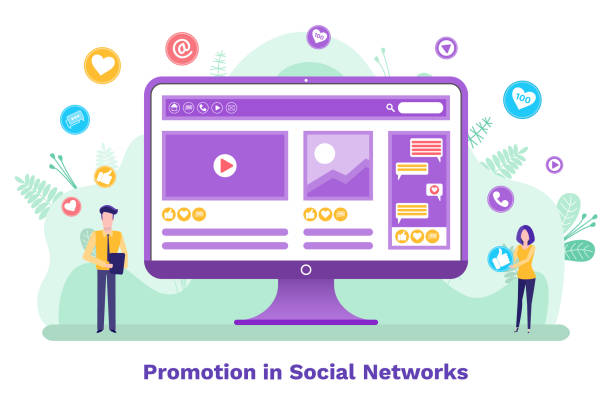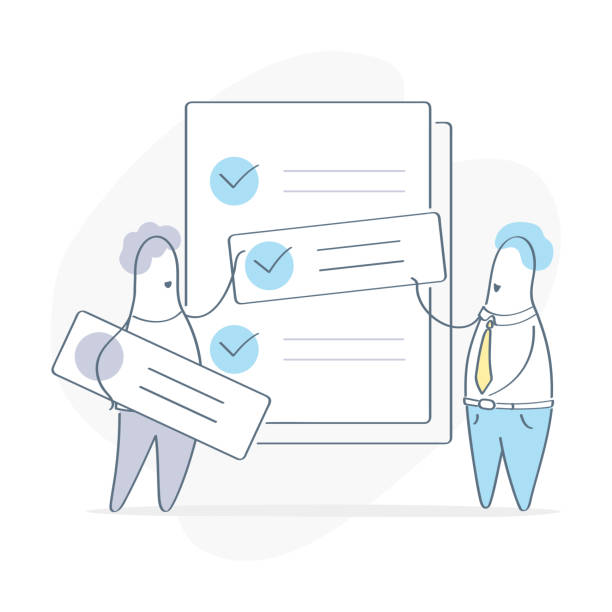Introduction to the Importance of Secure Website Design in the Digital World

In the current era where businesses are increasingly moving online, #secure_website_design is no longer a luxury, but a vital necessity.
Protecting #information_security and #user_privacy is of paramount importance, in addition to safeguarding brand reputation.
Cyberattacks including SQL injection, cross-site scripting (XSS), and DDoS attacks can lead to data loss, service disruption, and heavy financial damages.
Therefore, investing in a secure website structure not only reduces risks but also gains customer trust.
This descriptive section helps you gain a deeper understanding of the challenges and importance of website security.
Given the increasing complexity of threats, having a proactive approach to secure site design is essential.
Statistics show that many cyberattacks occur due to initial security weaknesses in website design and development.
This includes weak password management, lack of regular software updates, and the presence of known vulnerabilities in coding.
A comprehensive approach to cybersecurity must begin from the earliest stages of secure web development and continue throughout the website’s lifecycle.
Without attention to these details, even small businesses can become targets of sophisticated attacks with irreparable consequences.
Your website’s security is your business’s security.
It is important for every business, regardless of size, to have a clear strategy for secure site design.
This strategy should include regular vulnerability assessments, implementation of strong security protocols, and employee training.
Ignoring these aspects can lead to customer data breaches, loss of sensitive business data, and violation of data protection laws, all of which have legal and reputational consequences.
Therefore, careful planning for protecting your online platform is a foundation for sustainability and growth in the digital space.
Is your current e-commerce site design causing you to lose customers and sales?
Rasawweb is your solution with modern and user-friendly e-commerce site designs!
✅ Significant increase in conversion rates and sales
✅ Strong branding and gaining customer trust
⚡ Get a free e-commerce website design consultation from Rasawweb!
Basic Concepts of Web Security and Essential Protocols

To achieve #secure_website_design, understanding #basic_web_security_concepts and implementing standard protocols is of paramount importance.
One of the most important protocols is SSL/TLS certificate, which encrypts the communication between the user’s browser and the website server.
This protocol prevents unauthorized access to sensitive information such as passwords and bank card details.
Using SSL/TLS not only enhances security but is also beneficial for SEO, as Google ranks websites with HTTPS higher.
In addition to SSL/TLS, #Web_Application_Firewalls (WAF) play a vital role in secure site design.
WAFs filter incoming and outgoing website traffic and prevent common attacks such as SQL Injection and XSS.
Also, regular updates of server software, Content Management System (CMS), plugins, and themes are essential for maintaining website security.
Many cyberattacks exploit known vulnerabilities in outdated software.
Cybersecurity is a continuous process, not a static state.
Understanding how these protective layers work and implementing them correctly is one of the basic principles of secure website design.
Proper server configuration and the use of stable and secure versions of programming languages are also specialized concepts in secure web development.
For example, ensuring that access to critical server files is restricted and unnecessary ports are closed can significantly increase the website’s security level.
These preventive measures are the foundation of any online platform protection against growing threats and help you provide a secure online environment for your users.
By implementing these basic concepts, you can take solid steps towards enhancing your website’s security and minimizing security risks.
Choosing a Secure Platform and Host for Secure Website Design

One of the key decisions in #secure_website_design is choosing the right #platform and #host.
Content Management Systems (CMS) like WordPress, Joomla, or Drupal, must be carefully selected and up-to-date and secure versions should be used.
While these systems are very popular, they can create security weaknesses if not configured correctly and updated regularly.
Therefore, awareness of best security practices for your chosen CMS is a critical part of secure site design.
Choosing a reputable hosting provider is equally important; secure hosting offers measures such as advanced firewalls, regular backups, and intrusion detection systems.
A good hosting provider should have valid security certificates and continuously protect its servers against attacks.
This includes protection against DDoS attacks, network traffic monitoring, and providing strong spam filters.
Below is a comparative table of security features to consider when choosing hosting and platform.
This table will help you make more informed decisions for secure site design.
| Security Feature | Secure Hosting | Secure CMS (e.g., WordPress) |
|---|---|---|
| Free/Paid SSL/TLS Certificate | Usually provided | Supports but provided by host |
| Web Application Firewall (WAF) | Often provided at advanced levels | Can be installed via plugins |
| Regular Backups | Usually automatic | Can be done via plugin or manually |
| Intrusion Detection System (IDS) | Integral part of server security | Limited to log monitoring |
| Update Management | Server software updates | Core, plugin, and theme updates management |
| DDoS Protection | One of the main services of secure hosting | Indirectly, through hosting |
Remember that secure site design goes beyond just choosing the right host and platform.
It involves proper implementation, continuous maintenance, and regular updates.
Your hosting provider should have strong technical support for security issues and be able to react quickly in emergencies.
For more information on choosing secure hosting, you can refer to reliable sources.
This fundamental step is the cornerstone of protecting your online platform.
Security in Coding and Development for Online Platform Protection

The heart of every #website is its #coding, and #security_in_coding plays a vital role in #secure_website_design.
Even with the best hosting and platform, if the website code has vulnerabilities, it can become a gateway for attackers.
One of the main references in this field is the OWASP Top 10 list, which includes 10 common security vulnerabilities in web applications.
These vulnerabilities include Injection, Broken Authentication, and Cross-Site Scripting (XSS).
For secure web development, programmers must adhere to secure coding principles.
This includes strict user input validation, using Prepared Statements for preventing SQL Injection attacks, and Output Encoding for combating XSS.
Also, error handling and logging should be designed not to expose sensitive information.
Secure site design requires a comprehensive approach at all stages of development, from initial design to deployment and maintenance.
Every line of code written must be reviewed with its security implications in mind.
This process requires specialized and up-to-date knowledge of web vulnerabilities and prevention methods.
Applying the Principle of Least Privilege in access to resources and using up-to-date and well-known libraries and frameworks also greatly helps in protecting the online platform.
Many vulnerabilities are introduced into the system through the use of outdated or insecure components.
Performing regular code audits and using static and dynamic code analysis tools (SAST/DAST) can also help identify and fix weaknesses before deployment.
OWASP Top 10 is an essential guide for any developer looking for secure site design.
By following these specialized tips, we can ensure that our website is built securely from the ground up and is resilient against a wide range of attacks.
Worried about losing customers due to not having a professional e-commerce site?
With e-commerce site design by Rasawweb, forget these worries!
✅ Significant increase in sales and conversion rate from visitor to customer
✅ Professional and user-friendly design that gains customer trust
⚡ Get a free consultation from Rasawweb now!
Strong Password Management and Authentication in Secure Site Design

One of the most vulnerable points in any #online_system is #authentication and #password_management.
To achieve #secure_website_design, implementing strong password policies and multi-factor authentication (MFA) mechanisms is essential.
Weak and guessable passwords are the primary reason for account breaches.
Your website should require users to use complex passwords that include uppercase and lowercase letters, numbers, and symbols, and have an appropriate length.
In addition, password management should include secure storage using strong hashing functions and Salting to prevent dictionary and rainbow table attacks.
Also, the website should have the ability to lock an account after multiple unsuccessful login attempts to prevent brute-force attacks.
Providing the option for Two-Factor Authentication (2FA) or Multi-Factor Authentication (MFA) is another critical step in secure site design.
MFA adds an extra layer of security (such as a code sent to a mobile phone or app verification) that prevents unauthorized access even if the password is compromised.
Session Management is also an important part of this process.
Session tokens must be securely generated and stored, and expire after a specified time or inactivity.
This is especially crucial for websites that handle sensitive information.
Educating users about the importance of strong passwords and enabling MFA is also part of a comprehensive approach to secure site design.
Protecting your online platform depends on how securely your users and systems are authenticated.
By implementing these guidelines, you can significantly reduce the risk of unauthorized access to user accounts and enhance your website’s security.
Backup and Data Recovery for Secure Site Design Stability

In the world of #secure_website_design, no matter how strong preventive measures are, the possibility of an incident is never zero.
Data loss due to human error, cyberattacks, or hardware failure can be catastrophic.
For this reason, #regular_backup and having a #Disaster_Recovery_Plan (DRP) are of vital importance.
An effective backup plan should include a complete backup of the database, website files, and all configurations.
Backups should be scheduled to be performed automatically at regular intervals (daily, weekly) and stored in secure, separate locations (off-site from the main server).
This can include using secure cloud storage or physical backup servers.
Secure site design means not only preventing attacks but also being able to recover quickly and completely after an incident.
Without a strong backup strategy, even a small attack can lead to permanent loss of your business data and disrupt operations.
A Disaster Recovery Plan (DRP) should include step-by-step procedures for website and data recovery after a security or technical incident.
This includes regularly testing the recovery process to ensure its effectiveness.
Many businesses back up data but never test the recovery process, encountering serious problems when needed.
Protecting your online platform means preparing for the worst-case scenarios.
Having an up-to-date and tested DRP ensures that you can quickly restore your website to normal operation in case of any problem, minimizing negative impacts.
Enhancing your website’s security is completed with this additional defense layer, ensuring the stability of your business.
Monitoring and Incident Response for Website Security

For #secure_site_design, having #continuous_monitoring systems and an #Incident_Response_Plan are vital.
Even the most secure websites may be targeted by sophisticated attacks, and the ability to quickly detect intrusion and respond effectively can minimize damages.
Monitoring includes observing server logs, network traffic, suspicious user activities, and unauthorized file changes.
SIEM (Security Information and Event Management) tools can help collect and analyze these logs and issue timely alerts.
An incident response plan should include specific steps for identification, containment (limiting intrusion), eradication, recovery, and post-incident lessons learned.
Secure web development is not just about prevention, but also about preparedness for dealing with threats.
The security team or website administrators must clearly know their roles and responsibilities during an incident.
Secure site design is a live and dynamic process that requires continuous monitoring and updating based on new threats.
These measures are particularly important for websites that process sensitive financial or personal data.
Below is a table of the main stages of security incident response that can help you create your plan.
These stages should be regularly reviewed and practiced to ensure their effectiveness.
Proactive monitoring allows you to stop attacks before they cause serious damage.
Using SIEM solutions and IDS/IPS (Intrusion Detection/Prevention Systems) is an integral part of an advanced secure site design strategy.
| Stage | Description | Key Activities |
|---|---|---|
| 1. Preparation |
Developing policies, processes, and tools before an incident occurs. | Team training, role definition, tool preparation (SIEM, IDS/IPS). |
| 2. Identification |
Detecting and assessing suspicious activities or attacks. | Monitoring logs, analyzing alerts, confirming intrusion. |
| 3. Containment |
Preventing the spread of intrusion and reducing damage. | Isolating infected systems, cutting off attacker access. |
| 4. Eradication |
Completely removing the intrusion agent and related vulnerabilities. | Malware removal, patching vulnerabilities, restoring system to secure state. |
| 5. Recovery |
Restoring systems and services to normal operational state. | Restoring from backup, system testing, increased monitoring. |
| 6. Lessons Learned |
Analyzing the incident to improve future security policies. | Report preparation, weakness review, incident response plan update. |
Having a specialized team in incident response or collaborating with external security companies can also greatly help in protecting your online platform.
This level of preparedness marks the difference between a temporary disruption and a business catastrophe, demonstrating your commitment to secure site design and the sustainability of your business.
Penetration Testing and Security Assessment for Web Security Enhancement

One of the #specialized and #analytical approaches to ensuring #secure_site_design is conducting #Penetration_Testing and regular #security_assessments.
These processes help you identify and fix vulnerabilities and weaknesses in your website before attackers discover them.
Penetration testing is a simulated, controlled cyberattack performed by security professionals with the aim of discovering security holes.
These tests can include testing for known vulnerabilities (such as OWASP Top 10 items), checking for server misconfigurations, and testing resistance to specific attacks.
In addition to penetration tests, automated vulnerability scanners can also be regularly used to identify initial weaknesses.
However, manual penetration testing by experts provides a deeper level of analysis and can uncover vulnerabilities that automated tools cannot detect.
Secure site design is an ongoing process, and these tests should be performed regularly and after any major changes to the website.
The final penetration test report provides details of vulnerabilities found, their severity, and recommended solutions for fixing them.
This report provides a roadmap for enhancing your website’s security.
Companies should take these reports seriously and allocate necessary resources to fix deficiencies.
For more information on the importance of these tests, you can refer to Wikipedia on Penetration Testing.
Protecting your online platform requires independent and thorough assessments to ensure no security blind spots remain.
This proactive approach is an integral part of a comprehensive strategy for secure site design.
How much does losing business leads due to an unprofessional site cost you? Solve this problem forever with professional corporate site design by Rasawweb!
✅ Increase credibility and trust of potential customers
✅ Easier attraction of new business leads
⚡ Get a free consultation now!
User Training and Security Policies in Secure Site Design

The biggest #weakness in any security system is the #human_element.
To achieve #secure_site_design, educating users and developing strong security policies for all stakeholders (employees, managers, and even end-users) is crucial.
Many successful cyberattacks begin through social engineering or phishing, targeting unaware users.
Therefore, #security_awareness must become an integral part of the organizational culture.
User training should cover topics such as how to identify phishing emails, the importance of using strong and unique passwords, the necessity of enabling two-factor authentication, and the dangers of clicking on suspicious links.
These trainings should be conducted regularly and using educational and engaging content to be more effective.
Also, clear policies should be established and communicated regarding the use of personal devices at work, access to sensitive information, and methods for reporting security incidents.
Secure site design goes beyond program codes and also depends on user behavior.
Encouraging adherence to #best_security_practices and creating an open communication channel for reporting security concerns can greatly help in protecting your online platform.
For example, a website can provide simple and understandable guidelines for users on how to protect their accounts.
Security awareness training programs can significantly reduce the risk of successful attacks.
Remember that your website’s security is a collective responsibility, and by raising awareness among all involved parties, you can create a safer digital environment for yourself and your users.
Enhancing web security through training is a long-term investment in your business’s sustainability.
The Future of Secure Site Design and Emerging Challenges

The world of #cybersecurity is rapidly changing, and #secure_site_design must keep pace with these changes.
Emerging challenges such as #AI-powered_attacks, Internet of Things (IoT) threats, and Software Supply Chain Attacks have opened new horizons for security professionals.
The question is, are we sufficiently prepared to deal with these threats? Will today’s secure site design be enough for our digital tomorrow?
Artificial intelligence and machine learning are being used not only in defense but also in cyberattacks, making attacks more complex, intelligent, and targeted.
This requires secure web development professionals to also use AI to identify new attack patterns and predict future threats.
Also, with the widespread use of new technologies such as blockchain and Web 3.0, new security concepts are emerging that require novel approaches in secure site design.
The role of AI in cybersecurity is a growing area of research and application.
The questionable content is whether the speed of security technology development can match the speed of cyber threat evolution? This seems like an endless arms race where one must always be a step ahead.
Protecting the online platform in the future requires international cooperation, threat intelligence sharing, and significant investment in research and development.
Another challenge is maintaining privacy against extensive data collection and the use of tracking technologies, which can improve user experience but also bring security and privacy risks.
Enhancing web security in the future will go beyond mere coding and will include ethical and social aspects.
Frequently Asked Questions
| Question | Answer |
|---|---|
| 1. What does secure site design mean? | Secure site design means creating a website that is resistant to cyberattacks and protects user and server information. |
| 2. Why is security important in website design? | To prevent data breaches, maintain user privacy, retain user trust, and avoid financial and reputational losses. |
| 3. What are the most common web vulnerabilities? | SQL Injection, Cross-Site Scripting (XSS), Cross-Site Request Forgery (CSRF), Broken Authentication, and Security Misconfiguration. |
| 4. How can SQL Injection be prevented? | By using Prepared Statements / Parameterized Queries, ORMs, and Input Validation. |
| 5. What is the role of HTTPS and SSL/TLS in site security? | HTTPS, using the SSL/TLS protocol, encrypts the communication between the user’s browser and the server, preventing eavesdropping and data tampering. |
| 6. What measures should be taken to prevent XSS attacks? | Input validation, Output Encoding to prevent malicious code execution, and using Content Security Policy (CSP). |
| 7. What does a strong password policy include? | Enforcing long passwords, a combination of uppercase and lowercase letters, numbers, and special characters, and preventing reuse. |
| 8. How does two-factor authentication (2FA) help with security? | Even if the user’s password is compromised, the attacker cannot access the account without the second authentication factor (such as an SMS code or app). |
| 9. What is a Web Application Firewall (WAF) and what is its use? | A WAF is a firewall that monitors and filters HTTP traffic between a web application and the Internet to prevent common web attacks like SQL injection and XSS. |
| 10. Why is regular updating of software and libraries important? | Updates often include security patches to fix discovered vulnerabilities. Failure to update can expose the site to new attacks. |
And other services of Rasa Web advertising agency in the field of advertising
Smart Website Development: A novel service to improve campaign management through key page optimization.
Smart Advertising Campaign: A dedicated service for growth in customer behavior analysis based on key page optimization.
Smart Content Strategy: A combination of creativity and technology to increase click-through rates through SEO-driven content strategy.
Smart Data Analysis: A creative platform to improve online growth with attractive UI design.
Smart Google Ads: A novel service to improve SEO ranking through precise audience targeting.
And over a hundred other services in the field of internet advertising, advertising consultation, and organizational solutions
Internet Advertising | Advertising Strategy | Advertorial
Resources
Secure Website Design Tips
Website Security Checklist
Business Website Security
Importance of SSL Certificate
? With Rasawweb, transform your business in the digital world. By providing comprehensive digital marketing services, including exclusive website design, we help you shine in today’s competitive market and achieve your goals.
📍 Tehran, Mirdamad Street, next to Bank Markazi, Kazeroun Jonoubi Alley, Ramin Alley No. 6

